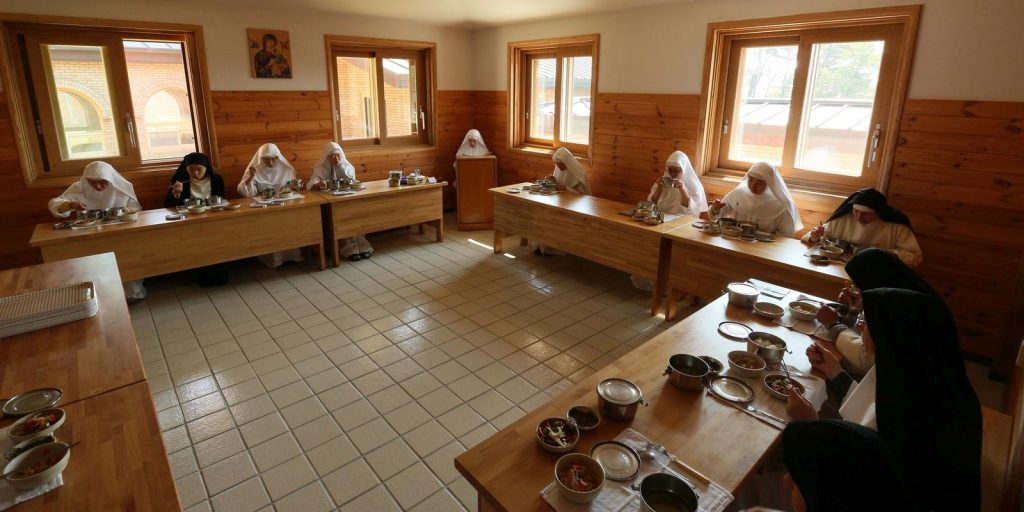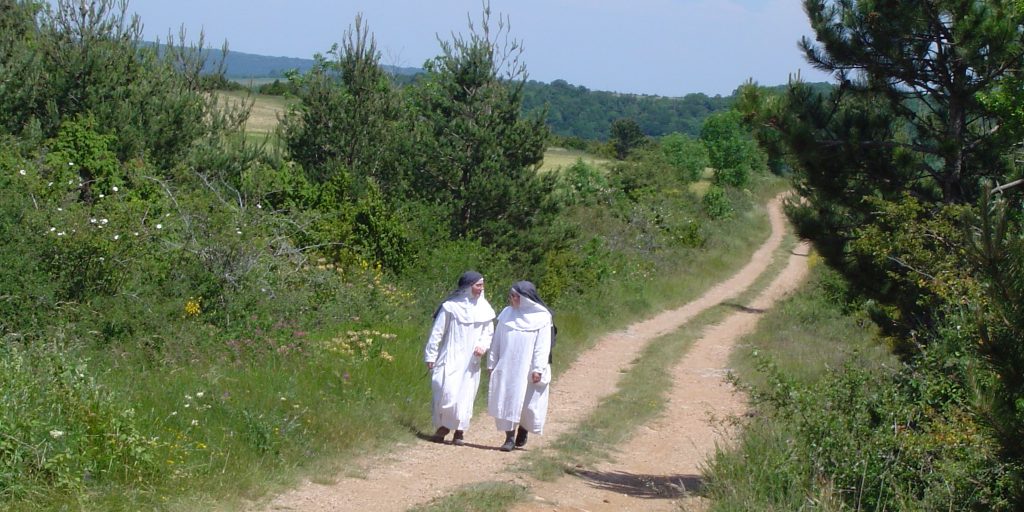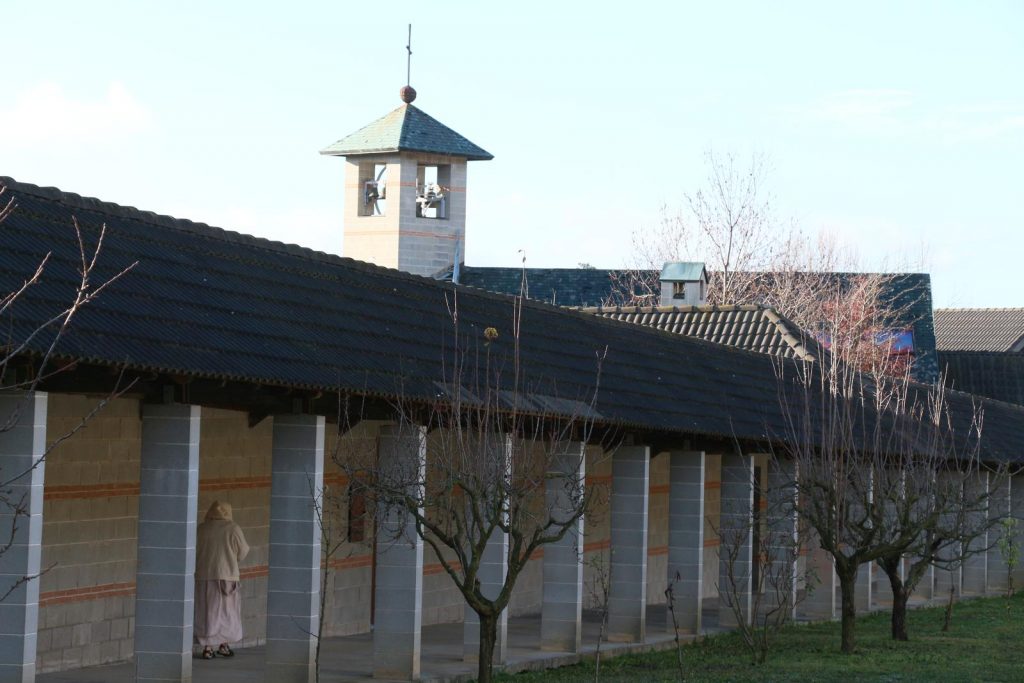In the retreat of their monasteries, in the solitude of their cells, the Carthusians spin Holy Church’s wedding garment.
(John-Paul II)
1. In Praise of God
When Saint Bruno leaves Reims, he knows what he is looking for, and he will not be distracted by having to abandon his first companions. Along with others, he left for Grenoble and allowed himself to be led to the desert of Chartreuse by Saint Hughes. All who know what this place is like in the middle of winter can only be impressed: the name “desert” for the Chartreuse is not exaggerated.
What was he looking for? Even today, the Statutes of the Order sum it up in one sentence: “To the praise of the glory of God, Christ, the Father’s Word, has through the Holy Spirit, from the beginning chosen certain men and women, whom he willed to lead into solitude and unite to himself in intimate love.” Yes, lovers have always sought to be alone, by themselves; so do not look elsewhere for another reason for the solitude found in the charterhouse.
Less than a century later, the nuns of Prébayon, in Provence, decided to embrace the rule of life of the Carthusian monks. Several times during the day, the Carthusian monks and the Carthusian nuns, forming a single body, sing the praise of God. Through participation in the Eucharistic sacrifice, through the divine office and the whole liturgy, the Carthusian family is united with Christ in the service of worship by the Church.

2. Solitude
« Leave you country, your kin and your father’s house and go ! » (Gn 12, 1). This call from God to Abraham, in order to make him a repository of a blessing, has been repeated several times in sacred history. This is the call to Moses and to the Hebrews who went into the desert and then to the prophets. The same call has resounded down through the centuries to the present day, and men and women have left everything to belong to God alone.
Our life as Carthusian nuns is a contemplative one marked by solitude, just like the monks. Our sole desire is to answer God’s call by returning love for Love. Our monasteries, far away from towns, are “deserts”, to aid our encounter with God. In truth, our supreme quest and goal is to find God in solitude and silence; « There (writes saint Bruno), indeed, as a man with his friend, do the Lord and his servant often speak together».
To the prophet Hosea God makes his promise clear: “I will seduce her, I will lead her to the wilderness, and I will speak to her heart” (Hosea 2,16). Jesus is driven by the Spirit into the desert (Mk.1,12) and there he remains alone with his Father. Jesus also invites us to enter into solitude to meet his Father: “But you, when you pray, withdraw to your inner most room, close the door and pray to your Father who is unseen; and your Father who sees all that is done in secret will reward you” (Mt. 6,6).
As he did to Jesus, the Holy Spirit continues to drive men and women into the wilderness. The first monks and nuns went to the deserts of Egypt and it was there that consecrated life was born. God sometimes asks for this break with our natural bonds, but he offers a new land: to be called to the “desert” is to choose to walk with the Lord without knowing where he will lead us. It is a way of life that allows a particular openness to divine things, it is to remain close to the Source. “In any case, what benefits and divine exaltation the silence and solitude of the desert hold in store for those who love it, only those who have experienced it can know.” (Letter from St Bruno to Ralph). But at the same time it is the place of trial and purification. This makes us able to better exercise our mission in the Church, praise, intercession, representation.

3. Communion of Hermits
When Jesus retreated to a deserted place to pray, he remained in communion with his disciples. Saint Bruno went to the “desert” of Chartreuse to live with God, but he did so with six other companions who had received the same call. Together they built the hermitages, together they joined in the praise of God in their chapel. Each monk in his hermitage prayed, read, worked, ate, slept, but this solitude did not distance him from his brothers who did the same thing at the same time. Communion between the brothers was intense, as can be seen in St Bruno’s letter to his brothers in Chartreuse. This union was rooted in God’s Love, Father, Son and Holy Spirit, remaining in each and every one.
Today’s monks and nuns aim for the same harmony between solitary and community life as their predecessors. They will be a communion of hermits if they allow themselves to be invaded by the love of Christ. It is through his love that they will love him and love their brothers and sisters, in an undivided way. Solitary life, in cells or in obediences, ignites and nourishes in our hearts the fire of divine love. By which each is joined to the other.
A symbol of this communion of hermits lies in the plan of the buildings of a charterhouse: each hermitage or “cell” has a small house and a garden; this “cell” opens onto a cloister leading to communal areas, church, chapter, refectory, library.
The life of communion is manifested by the daily liturgy sung in the church, but it is experienced more on Sundays and feast days: Sunday lunch is taken together in the refectory and in the afternoon a community meeting takes place. On this day, tierce and none are also sung in church. Through these meetings, a greater emphasis is given to the consolation that family life brings.


This weekly gathering brings us together: it is a meeting of friendship and an in-depth sharing of the Word of the Lord, in the light of which we then try to direct our lives.
In addition, once a week, we have another mutual exchange during a walk, called a “spaciement”, which lasts about three hours. Each one can talk in turn with one of the others, which promotes a union of souls and a sense of fulfilment, maintains mutual affection, ensures good physical relaxation and helps us to live in solitude during the rest of the time.

Located a few meters from the monastery, a hermitage houses Carthusian monks who share our liturgical life. The father or fathers celebrate the Eucharist and the other sacraments.
4. At the Heart of the Church
Communion does not exist only between the members of the same Charterhouse, or only between all the sons and daughters of St. Bruno. This unity is also with the Church visible and invisible. Choosing a solitary life does not make us desert the human family. Union with God, if true, does not close us in on ourselves, but instead opens our minds and expands our hearts, to the point of embracing the whole world and the mystery of Christ’s Redemption.
Separated from all, we are united with all: and so it is in the name of all that we stand in the presence of the living God. Solitary prayer is the gift that God and the Church have entrusted to us, our cooperation in the unceasing work of Christ: “My Father works and I too work” (Jn 5,17). The Carthusian nun, while being faithful to the call received from God, also gives her life for her brothers and sisters in the world, because the prayer of each is for all, and the prayer of all is for each, on earth and in heaven. The Holy Spirit awakens Christ’s prayer in us through faith and love. Because we are members of his body, our prayer is his, our silence announces his good news and our vigil his coming.
At the heart of the Church, the Carthusians are called by God to “live in communion with his Son, Jesus Christ” (1Co 1,9), imitating him in his hidden life of Nazareth and praying with him on the mountain. To be orientated only towards the One who is, expands the heart and makes it capable of carrying in God the aspirations and sufferings of the world. But Carthusian life testifies above all to God’s love, that his love is enough to fill a life, that he must be loved freely as he loved us, simply because he deserves it, in praise of his glory.












